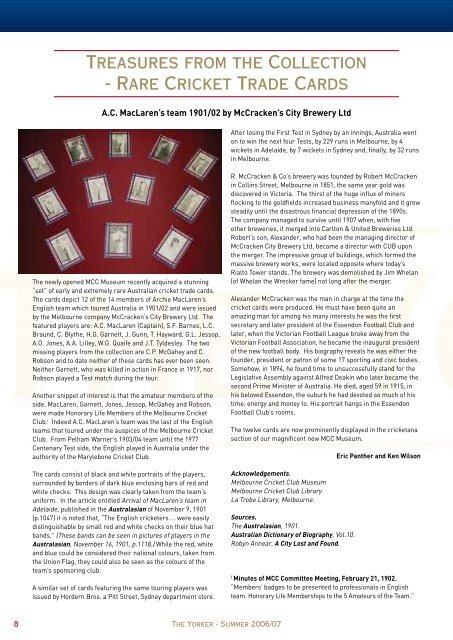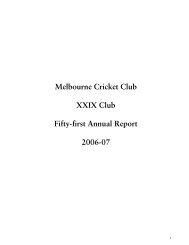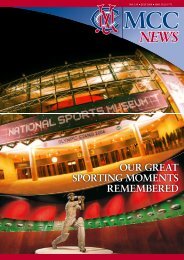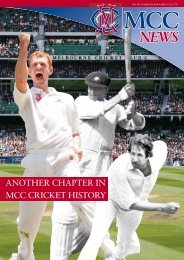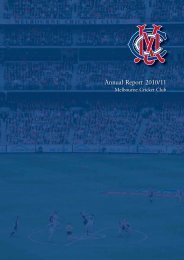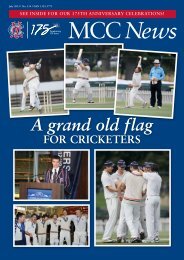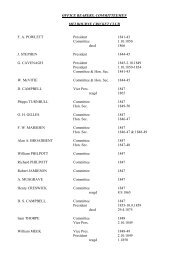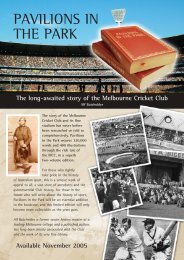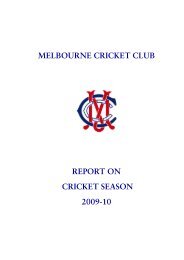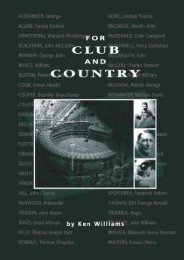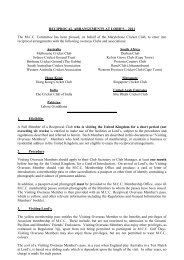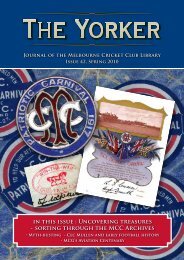Issue 36: Summer 2006/07 - Melbourne Cricket Club
Issue 36: Summer 2006/07 - Melbourne Cricket Club
Issue 36: Summer 2006/07 - Melbourne Cricket Club
You also want an ePaper? Increase the reach of your titles
YUMPU automatically turns print PDFs into web optimized ePapers that Google loves.
Treasures from the Collection- Rare <strong>Cricket</strong> Trade CardsA.C. MacLaren’s team 1901/02 by McCracken’s City Brewery LtdAfter losing the First Test in Sydney by an innings, Australia wenton to win the next four Tests, by 229 runs in <strong>Melbourne</strong>, by 4wickets in Adelaide, by 7 wickets in Sydney and, finally, by 32 runsin <strong>Melbourne</strong>.The newly opened MCC Museum recently acquired a stunning“set” of early and extremely rare Australian cricket trade cards.The cards depict 12 of the 14 members of Archie MacLaren’sEnglish team which toured Australia in 1901/02 and were issuedby the <strong>Melbourne</strong> company McCracken’s City Brewery Ltd. Thefeatured players are: A.C. MacLaren (Captain), S.F. Barnes, L.C.Braund, C. Blythe, H.G. Garnett, J. Gunn, T. Hayward, G.L. Jessop,A.O. Jones, A.A. Lilley, W.G. Quaife and J.T. Tyldesley. The twomissing players from the collection are C.P. McGahey and C.Robson and to date neither of these cards has ever been seen.Neither Garnett, who was killed in action in France in 1917, norRobson played a Test match during the tour.Another snippet of interest is that the amateur members of theside, MacLaren, Garnett, Jones, Jessop, McGahey and Robson,were made Honorary Life Members of the <strong>Melbourne</strong> <strong>Cricket</strong><strong>Club</strong>. i Indeed A.C. MacLaren’s team was the last of the Englishteams that toured under the auspices of the <strong>Melbourne</strong> <strong>Cricket</strong><strong>Club</strong>. From Pelham Warner’s 1903/04 team until the 1977Centenary Test side, the English played in Australia under theauthority of the Marylebone <strong>Cricket</strong> <strong>Club</strong>.The cards consist of black and white portraits of the players,surrounded by borders of dark blue enclosing bars of red andwhite checks. This design was clearly taken from the team’suniform. In the article entitled Arrival of MacLaren’s team inAdelaide, published in the Australasian of November 9, 1901(p.1047) it is noted that, “The English cricketers ... were easilydistinguishable by small red and white checks on their blue hatbands.” (These bands can be seen in pictures of players in theAustralasian, November 16, 1901, p.1118.) While the red, whiteand blue could be considered their national colours, taken fromthe Union Flag, they could also be seen as the colours of theteam’s sponsoring club.A similar set of cards featuring the same touring players wasissued by Hordern Bros. a Pitt Street, Sydney department store.R. McCracken & Co’s brewery was founded by Robert McCrackenin Collins Street, <strong>Melbourne</strong> in 1851, the same year gold wasdiscovered in Victoria. The thirst of the huge influx of minersflocking to the goldfields increased business manyfold and it grewsteadily until the disastrous financial depression of the 1890s.The company managed to survive until 19<strong>07</strong> when, with fiveother breweries, it merged into Carlton & United Breweries Ltd.Robert’s son, Alexander, who had been the managing director ofMcCracken City Brewery Ltd, became a director with CUB uponthe merger. The impressive group of buildings, which formed themassive brewery works, were located opposite where today’sRialto Tower stands. The brewery was demolished by Jim Whelan(of Whelan the Wrecker fame) not long after the merger.Alexander McCracken was the man in charge at the time thecricket cards were produced. He must have been quite anamazing man for among his many interests he was the firstsecretary and later president of the Essendon Football <strong>Club</strong> andlater, when the Victorian Football League broke away from theVictorian Football Association, he became the inaugural presidentof the new football body. His biography reveals he was either thefounder, president or patron of some 17 sporting and civic bodies.Somehow, in 1894, he found time to unsuccessfully stand for theLegislative Assembly against Alfred Deakin who later became thesecond Prime Minister of Australia. He died, aged 59 in 1915, inhis beloved Essendon, the suburb he had devoted so much of histime, energy and money to. His portrait hangs in the EssendonFootball <strong>Club</strong>’s rooms.The twelve cards are now prominently displayed in the cricketanasection of our magnificent new MCC Museum.Acknowledgements.<strong>Melbourne</strong> <strong>Cricket</strong> <strong>Club</strong> Museum<strong>Melbourne</strong> <strong>Cricket</strong> <strong>Club</strong> LibraryLa Trobe Library, <strong>Melbourne</strong>.Sources.The Australasian, 1901.Australian Dictionary of Biography, Vol.10.Robyn Annear, A City Lost and Found.Eric Panther and Ken WilsoniMinutes of MCC Committee Meeting, February 21, 1902.“Members’ badges to be presented to professionals in Englishteam. Honorary Life Memberships to the 5 Amateurs of the Team.”The Yorker - <strong>Summer</strong> <strong>2006</strong>/<strong>07</strong>


